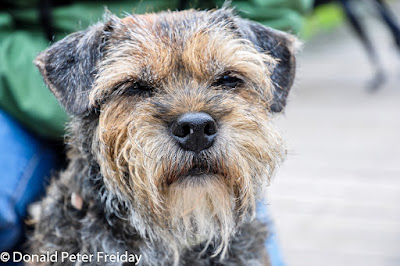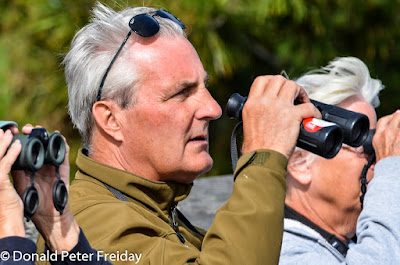[A Kentucky Warbler in your right hand, a starving child's in your left. What do you do? Feed the warbler to the child?
The pain of triage.]
(The previous posts on this thread were published on January 5, January 17, January 25, and February 12, 2020, find them by clicking on the main banner above and then scrolling down, or under "Time Machine" at right, depending on how you're viewing this).
Many fantastic people and great organizations work to conserve NJ birds, either directly or as a consequence of other actions like land acquisition or water quality protection. This is a very good thing, and we should bow before these people and groups.
We know birds are declining. Surely folks reading this have heard about the article in the journal
Science last fall. You can
read about the article in the New York Times, find a
summary provided by Cornell, or
track down the full article. This study was important; it brought wider attention to the issue and appeared in one of the most prestigious journals extant. But. Ken Rosenberg of Cornell, lead author of the study, and a friend who I greatly admire, was quoted by the
Times: "We were stunned by the result. . ." No you weren't, Ken. Those words needed to be said, perhaps, but we've known about this for decades.
Birds are declining, but are not over the cliff, and don't have to go over if we organize and cooperate correctly, triage correctly to apportion resources the best possible way, and as much as possible increase available resources for bird conservation.
Are we doing this? No. Not as well as we must.
Organize and cooperate: It has often been said that wildlife ignores political boundaries, which is true and which is responsible for the emergence of "joint ventures," a number of which deal with NJ. Like the Atlantic Coast Joint Venture and the Appalachian Mountain Joint Venture. You can read about joint ventures for birds at
Partners in Flight ,
Migratory Bird Joint Ventures, and the
USFWS.
Birds don't follow political boundaries, but humans do, and we are stuck being humans (if you could be a bird, which one. . . ?) From a human standpoint, states are pretty organized: counties, municipalities, public lands, private lands. The existing joint ventures do great work, but from an NJ perspective are arguably a bit too geographically and organizationally cumbersome.
I think it is time for a New Jersey Bird Conservation Joint Venture, with a guiding board, a master plan, and an annual conference.
This could start with the annual conference. Any organizations interested? I volunteer to help. (There's
a program March 7, 2020 at Stockton University sponsored by the Friends of Forsythe and NJA that sounds interesting, about the study published in
Science.)
Do we really need another organization? I don't know. Maybe. A permanent, united organization of organizations and interested individuals. Why? Because, all these bird conservation cats are running in all manner of directions pursuing conservation success (awesome!!!) and where money can be found and media attention can be gained (less awesome, sometimes necessary; how many times has it been said, "No money, no mission"?) There is some very good effort at alliances and coalitions in NJ, but also not a little tribalism.
So we get all these cats in a room and agree to be a herd.
Conservation Triage. Triage is often used in a medical sense. You've got limited medical staff, resources and time, so who gets treated in what order? Patients who will live without immediate care wait, patients who will die without immediate medical care go to the top of the list, patients without a chance of living die. Awful stuff.
Triage spans all the world's problems, including conservation. There will never be enough resources for everything. I took a crack at identifying the top threats to NJ birds in prior posts. I don't know if I
got it right and I don't mind being wrong. I mind very much if we collectively don't get it right.
NJDFW's NJENSP creates
species status lists. Great effort, especially in the face of uncertainty. I have participated in the Delphi Technique used by ENSP, and it's daunting. We can know in our hearts that, say, Black-throated Blue Warblers are declining because we just don't see as many anymore, but putting the modern equivalent of the little old person with binoculars in front of the people who hold the reins and make decisions won't feed those bulldogs and their attorneys. We've got to have the data, again showing why the
Science article was so important. Painting the decline picture without data may work fine with the general public, however. Don't bother me with the facts. Sigh.
Identifying the most important threats to birds is tricky. You like eagles, I like warblers, hunters like ducks, salt marsh muckers like rails. Do we treat the movie stars, the rank and file, the political leaders, or the starving children? Then you must ask, what time scale are we talking about? Other than sea level rise (which is going to f___ many birds and humans in a few decades' time), I didn't really even mention climate change, because I don't think enough is scientifically known or predictable about what warmer temperatures, early plant emergence, changes to insect phenology, and other climate effects will do in eastern landscapes or when. White-tailed Ptarmigan and Pikas out in the Rockies are probably screwed. Brian Moscatello astutely pointed out to me that if West Nile is killing Ruffed Grouse and climate change lets West Nile mosquitoes go up in elevation, grouse are in for it. Pragmatically, what are we going to do about the climate change that is already out there but will require a major shift of public and political will? I'm NOT saying don't try.
I'm willing to bet the number one cause of NJ bird loss in the last 100 years is habitat destruction. What will be number one in 2020? Dunno, human-subsidized predators? In the next hundred years? Climate change? Massive destruction of wintering habitats south of the U.S.?
This is important. We've got to get this triage bit right, and keep revising it as we learn more. Here's an example: Bald Eagles. I love them, I birded when there was one NJ nesting pair and one member of the pair died, as I recall. Now, over 200 pairs nest annually in NJ, which is great and more than those of NJ Northern Harriers, Sharp-shinned Hawks, Northern Goshawks, Red-shouldered Hawks, maybe Broad-winged Hawks, Peregrine Falcons, and American Kestrels, and that's just the day-flying raptors, all outnumbered by Bald Eagles. Which begs the question: should we spend any money or time on Bald Eagles anymore? I mean in no way to disrespect the many people, many who I count as friends, who worked and work for Bald Eagles.
I think we should put Dave Golden, the talented Director of NJDFW, along with whoever becomes the new head of ENSP, in front of a Bald Eagle statue draped with a banner proclaiming MISSION ACCOMPLISHED. Cut to Dave, who is saying, "With your help, we did it with Bald Eagle. With your help, we can do it with many others."
The triage bottom line is this; We've got roughly 350 bird species that occur annually in NJ, and roughly 212 that nest. How many of these get enough conservation attention, and are they the right ones?
We do not inherit the earth from our parents. We leave it for our children.
(-Somebody very wise said this, exactly who is debated but so what. It's true.)
Who am I to be writing this, and why? I'm a guy who likes birds, and cares about the future. I definitely have no problem being shown I am wrong, in fact I like it, because then I learn.
You can find a bio on this blog (I'm exploring new work options in conservation and would be delighted to shoot out a full résumé.) I hitched my cart to nature at a very young age, and in a life with the usual apportionment of mishaps and mistakes, this was a very smart thing. I reckon there's no point denying I know a lot about birds and ecology, and after all this time there would be no excuse not to, most especially because not to know would be letting down the many teachers, friends, and colleagues who have shared their knowledge and wisdom with me. This is dangerous because I know I'm apt to leave someone out, but these folks perhaps do not know how much I owe them: the natural resources and biology staff of Rutgers, including Dr.'s Jim Applegate, Len Wolgast, Ted Stiles, Tim Casey, Professor Goldfarb, John Kuser, Dr. Trout, David and Joan Ehrenfeld; professional colleagues, some also supervisors, and friends including Rich Kane, Pat Kane, Pam Thier, Emily Amon, Pete Dunne, Tom Gilmore, John Parke, Troy Ettel, Brian Vernachio, Sean Grace, Scott Barnes, Pete Bacinski, Karl Anderson, Paul Castelli, Vinny Turner, Bill Crouch, Sandy Perchetti, Roger Dutch; friends, teachers and field companions Mark Garland, Mel Ogola, Gustavo Orosco, Dave Womer, Dave Dendler, Rex Miller, Will Russell, Ken Knowles, Richard Crossley, Kevin Karlson, Scott Whittle, Michael O'Brien, Bill Boyle, Tom Reed, Dr. Emile DeVito, Wade and Sharon Wander, Kathy Clark, Ted Nichols, Todd Pover, Kashi Davis, Linda Dunne, Dani Kaschube, and probably others I am missing. These people are why, when I am wrong about anything natural, I have no excuse.
Postscript: preliminary thoughts on a New Jersey Bird Conservation Joint Venture
Joint ventures happen in the business world, too. The definition is basically the same: A joint venture (JV) is an arrangement in which two or more parties agree to pool their resources for the purpose of accomplishing a specific task.
Who gets invited to the table? Off the cuff: NJDFW, NJENSP/Conserve Wildlife, USFWS, NPS, NJFS, NJPS, TNC, NJA, NJCF, NJTWS, one or more land trusts, ANJEC (Association of NJ Environmental Commissions), DU, TU, NJ Federation of Sportsman's Clubs, one or more industries (PSE&G, EMS, REI, Bass Pro Shops), NJ Saltwater Sportsmen, NJ Waterfowler's Association, one or more foundations, someone from the U.S. military, some NJ birders, maybe out of NJBRC. I'm sure I've made errors of omission.
Please, let's not beat this part to death (you can probably tell I've been through a bunch of these), but we come up with a framework which includes the standards:
I. Vision/Mission Statement, perhaps a wordsmithed version of "Lots of birds of lots of species."
II. Strategies: (Throw in goals above this if you want to add a layer). Time-based, measurable, all that yadda yadda, importantly identifying what person/people, agency/agencies, organization/organizations are going to take the lead and who will help and how. OK, ENSP, you've got beach-nesters and colonial waterbirds. OK, USFWS, you've got the refuges. OK, DU, NJDFW, NJ Waterfowler's, you've got migratory gamebirds. OK, NJDFW, you've got resident gamebirds. OK, somebody, you've got the annual conference. Ok, somebody else, you've got a once-annual publication. OK, somebody else, you've got media relations and social media. OK, all the above, here's your support team and what they will do. Something like that.
III. Tactical/Step-down Plans. Maybe based on the plan of the agency/organization that has the lead on the particular matter, be the matter a species, a habitat, or a threat.
IV. Contingency Plans, like for an oil spill, or big fire season, Perhaps these already exist.




















































































